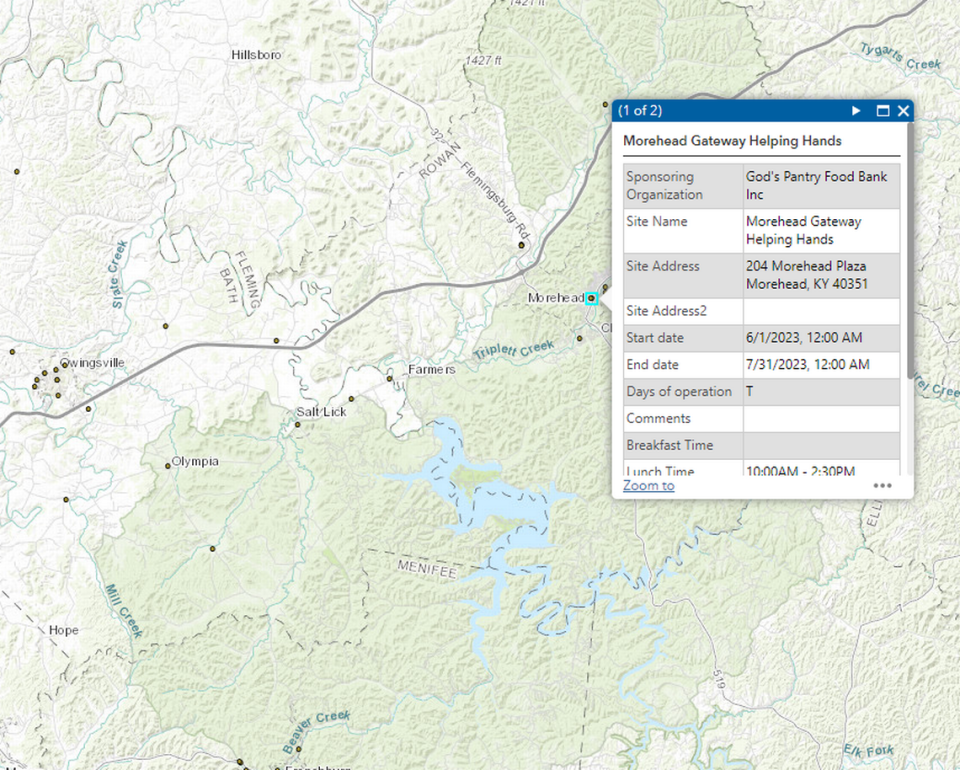Here’s how to find a kids’ summer meals program near you in Kentucky
Many Kentucky families depend on school-provided meals to give their kids access to nutritious foods during the academic year. But what about during the summer months?
“Families that have kids that are getting free or reduced school lunches during the year, their budget doesn’t grow when those kids are home from school,” said Cathy Gallagher, who manages the Kentucky Department of Education’s summer food program.
Food insecurity — the lack of reliable access to nutritious foods — plagues every county in Kentucky, but the state’s rural populations tend to face the issue more often especially as pandemic-related food provisions have ended.
Anyone 18 or younger is eligible to receive summer meals. This summer there are nearly 2,000 summer meal distribution sites across the state, and new federal rules passed by Congress last year could soon help summer meal programs better serve rural areas. According to Gallagher, one of the biggest barriers to accessing summer meals is a lack of awareness about where the food is distributed.
How to find a summer meal program near me
The easiest way to find your nearest summer meal site is by texting “food” or “comida” to 304304.
After the text, the number will reply asking for your street address. After inputting that, the number will provide a list of the nearest food site locations, Gallagher said.
If you’d rather call, you can dial the USDA’s hunger hotline at 1-866-3-HUNGRY or 1-877-8-HAMBRE.
For those who would rather look at a map, the USDA provides a detailed online map which shows summer food distribution sites across the country. The map also provides the general days and times when meals will be provided.
The meals are often distributed by school districts, libraries, churches, non-profits or other community organizations. The times, dates and the manner in which food is distributed can vary by location so checking an organization’s social media page or website to confirm how meals are being served is recommended, said Kate McDonald Goodin, the No Kid Hungry Kentucky campaign director.
For example, a meal site may say they distribute food every day but it may mean the site is distributing pick-up meals in bulk that could last for potentially a whole week. So you would “want to confirm what day pick up is happening,” McDonald Goodin said.

What is the Summer Food Service Program?
Last year, over 3 million summer meals were distributed in Kentucky, Gallagher said. Any safe space can be considered a meal site, she said, noting that at times meals have been served everywhere from national parks to barber shops.
Those meals were distributed through the Summer Food Service Program, a decades-old, federally funded but state-administered service providing no-cost food for anyone 18 or younger.
“It really just ensures that there’s good nutritious food available for kids during the summer,” Gallagher said. “And there’s a lot of hungry kids in Kentucky.”
The meals are balanced and meal sites are encouraged to source food locally when they prepare and serve the meals, Gallagher said. Some places, like schools or non-profits, have commercial kitchens where the food can be prepped. Last year, more than 77% of the organizations providing summer meals were school districts.
“They’re just working year round to ensure these kids are well nourished,” Gallagher said of the school employees.
Changes to the program for rural areas
For much of the program’s existence, meals had to be served and eaten on location in “congregate settings.” The COVID-19 pandemic forced exceptions for “non-congregate” meal service, allowing for some pick up and delivery options. In December, Congress passed a measure allowing for non-congregate meals to be served permanently in rural areas.
“We’re really excited about the possibility of what this can turn into,” McDonald Goodin said. The new rule allows for locations to utilize pick-up, some delivery options and the ability to provide food in bulk.
Many very rural counties in Kentucky may already be using non-congregate meal service, she said, but emphasized checking directly with the particular location you’re getting your meals from.
“I think what a lot of folks are doing is putting together a meal pack of five days or something like that,” Gallagher said. “So a family, if they can get transportation in, they can pick up multiple days worth of meals.”
Since this is the first year after the rule change, many meal sites may be still learning how to best implement the program, Gallagher said. At the moment, the logistical challenges of home delivery will likely make that option less available but some groups are exploring ways to get food to families who might not have transportation.
“It is such a year of transition,” Gallagher said. “But we have seen that embraced by some of our nonprofit sponsors that are working in multiple counties and trying to get to those families who can’t get to sites.”

